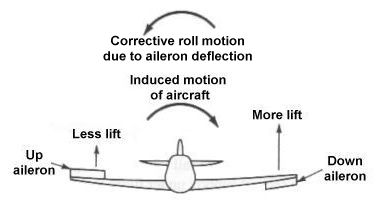|
||||||||||
|
|
||||||||||
|
||||||||||
|
|
||||||||||
The torque problem comes from Newton's basic law of motion which states that "For every action there is an equal and opposite reaction." Therefore, as a helicopter's engine spins the main rotor in one direction, the helicopter body wants to spin in the opposite direction. However, the smaller rotor on the tailboom creates a force, or more correctly a moment (which is the force multiplied by the distance between the main and tail rotors), that counteracts the induced spin of the body and keeps the helicopter in equilibrium.
To answer your question, yes, propeller-driven aircraft do indeed suffer from the same effect. When viewed from the front, most propellers turn counterclockwise, so the rest of the plane has a tendency to rotate clockwise, or left-wing down.

While helicopters use a separate device to address this problem, this tendency is usually counteracted by pilot control inputs alone on an airplane. Since the plane wants to roll to the left, he will apply right aileron (i.e. deflect the left aileron down, right aileron goes up) to increase the lift on the left wing creating a right-roll moment. This moment counteracts the rolling motion induced by the propeller torque and returns the aircraft to a wings-level configuration.

However, this aileron deflection has the effect of making the aircraft asymmetric, or uneven, because one side of the plane produces more lift than the other. When this situation occurs, that side of the aircraft also produces more drag than the other. This increase in drag on the left side of the plane causes it to yaw to the left, an effect known as adverse yaw. To correct for this yaw effect, the pilot must also apply right-rudder (rudder deflects to the right) to counteract the adverse yaw and keep the nose pointed stratight ahead.

We might expect that dealing with all these balancing motions and corrective measures would be somewhat tiring to the pilot, but the effect is not that great for most aircraft. Pilots usually maintain trim by instinct and familiarity with the flight characteristics of the particular aircraft. However, torque-roll has caused many accidents when the pilot entered a flight regime he was not familiar with. For example, when the engine fails, the torque effect disappears and the pilot must realize how this changes the flight characteristics.
A more common example comes from the operation of piston aircraft from aircraft carriers. When a pilot misses the landing wires on a carrier deck, he goes to full power to take off again and go around for another attempt. This sudden increase in power also generates a sudden increase in torque that the pilot may not be prepared to compensate for. Complicating the issue even more is that landing occurs at relatively low speeds. When the speed of the air flow passing over the aileron and rudder is slow, these surfaces loss much of their effectiveness and may not be able to counteract the torque.
Another method of counteracting the torque effect is the use of contrarotating propellers, or propellers that rotate in opposite directions. As piston engines became increasingly powerful in the 1940s, some single-engine aircraft required contrarotating propellers to remain controllable. The Supermarine Seafire and Maachi M72 are examples of aircraft with such powerful engines that they needed twin contrarotating props on the same shaft to cancel the torque effect. Contrarotating props also offer advantages in eliminating other assymetrical effects and were found to give aircraft much better handling characteristics.
In addition, the torque effect can be completely eliminated on multi-engined aircraft in a similar manner. Most twin-engined or four-engined piston aircraft use propellers that rotate in opposite directions to negate the torque effect. By rotating the right engine clockwise and the left engine counterclockwise, for example, the torques will cancel without any corrective action being necessary.
Finally, keep in mind that any rotating component creates assymetrical forces and moments on aircraft. Even the
rotating fans and turbines in modern jet engines will do so, but these effects are usually so small that they are
difficult to notice. In addition, modern fly-by-wire control systems probably correct for these effects
automatically.
- answer by Jeff Scott, 25 February 2001
Read More Articles:


|
Aircraft | Design | Ask Us | Shop | Search |

|
|
| About Us | Contact Us | Copyright © 1997- | |||
|
|
|||